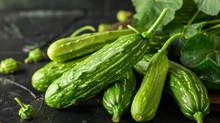
As the scorching heat of summer sets in, many gardeners find themselves struggling to maintain a healthy vegetable garden. However, there's no need to despair. By selecting the right plants, you can ensure a bountiful harvest even during the hottest months of the year. Here are seven heat-tolerant vegetable plants that thrive in high temperatures and even flourish in hot conditions:
1. Okra:
Okra, also known as Lady Finger or Bhindi, is a favorite in many summer gardens because of its ability to flourish in warm and humid weather. This heat-loving plant thrives in full sun and well-drained soil. Okra's big leaves and sturdy stems let it to withstand the summer's heat without withering. Plus, any garden is made more beautiful by its vivid yellow blooms.
It grows best in enriched soil with a pH of 6.5-7, spaced 7-8 inches apart, and requires 5-6 hours of sunlight daily. Regular morning watering is key, with the first harvest typically ready 45-50 days after planting. For detailed guidance, a comprehensive growing manual awaits aspiring Okra gardeners.

2. Tomato:
Tomatoes thrive under the warmth of the sun, making them an excellent addition to any garden. In fact, tomatoes require plenty of sunlight to produce sweet and juicy fruits. For best results, choose heat-tolerant tomato varieties like "Vaishali" and "Sun Gold". Cherry tomatoes stand out due to their exceptional heat tolerance for a successful harvest during the summer months, make sure to provide adequate water and support for your plants.
For successful tomato growth at home, ensure the soil pH is 6-6.8, space seeds 3-4 inches apart, provide 5-6 hours of sunlight daily, water minimally during germination, and increase water as plants grow. Expect the first harvest 65-70 days after transplanting, which typically occurs 6-8 weeks after indoor sowing.

3. Ginger:
Adding ginger to your vegetable garden brings both culinary delight and health benefits. Thriving in warm weather, ginger prefers well-drained, loamy soil with indirect sunlight. Keep the soil consistently moist but not waterlogged. Harvest ginger rhizomes selectively approximately 8-10 months after planting. With proper care, ginger enhances garden diversity and provides fresh spice for culinary and medicinal use.

4. Yard Long Beans:
Yard long beans, also known as asparagus beans or snake beans, are a heat-loving alternative to traditional bush beans. Rich in protein, Vitamin C, and Vitamin A, these slim pods not only facilitate weight loss but also possess properties that restrain the increase of cancer cells in the body.
These quick-growing vines grow up to 18-inch-long. For successful growth, yard long beans require optimal conditions: well-drained loamy soil with a pH of 6.0 to 7.5, direct sunlight for 5 to 6 hours daily, adequate watering, and harvest the beans regularly to encourage continuous production.

5. Basil:
Basil is not just a cooking herb; it's also heat-tolerant plant and perfect for cultivation at home during hot months. With its fragrant leaves and soft flowers, basil adds flavor and aroma to summer dishes.
To ensure a successful basil harvest at home, remember to provide optimal growing conditions. This includes planting basil in a sunny spot with fertile, well-drained loamy soil with a slightly acidic pH, spacing seeds appropriately, maintaining soil moisture, and harvesting the leaves approximately 30-35 days after sowing. Pinch off the flower buds to encourage healthiergrowth and prolong the harvest. Regular harvesting will also prevent the plants from becoming woody.

6. Brinjals (Eggplant):
Brinjals, or eggplants, thrive in hot climates and can withstand temperatures above 75°F (24°C), making them an excellent addition to your home garden during the summer months. Besides their culinary uses, incorporating eggplants into your garden can offer health benefits. These benefits include reducing the risk of diabetes and heart disease.
To grow brinjals at home successfully, remember these key points: These heat-loving vegetables require full sun and well-drained soil to flourish. Varieties like "Black Beauty" are particularly well-suited for summer cultivation. Regular watering and mulching can help conserve moisture and keep the plants healthy during hot spells.

7.Chillies (Peppers):
Whether you prefer sweet bell peppers or spicy chili peppers, you're in luck – both types thrive in hot weather. Not only do they add depth to our dishes, but they also elevate them to new levels of deliciousness. You can improve your culinary experience by growing heat-tolerant chili plants at home, providing freshness to every dish.
Growing chillies at home requires attention to soil conditions, sunlight exposure, germination, transplantation, and watering. Peppers require plenty of sunlight and warmth to produce fruits. Choose varieties suited to your taste and heat preference. Mulch around the plants to conserve moisture and regulate soil temperature.

8. Amaranthus:
Amaranthus, also known as amaranth or callaloo, is a nutritious leafy green that thrives in hot, sunny conditions. It is an excellent choice for individuals adhering to a gluten-free diet due to its high protein content and easy digestibility. This heat-tolerant plant is not only edible but also decorative, with its vibrant leaves and striking flowers.
To grow Amaranthus at home successfully, remember these key points: Plant amaranthus in a sunny spot with fertile soil, and water regularly to keep the plants hydrated. Harvest the tender young leaves for use in salads, stir-fries, or soups.
With the right selection of heat-tolerant vegetable plants, you can enjoy a productive garden even during the hottest months of the year. Whether you're growing okra, tomatoes, brinjals, basil, chillies, yard long beans, or amaranthus, be sure to provide ample sunlight, water, and care to ensure a successful harvest. With a little effort and attention, your summer garden can thrive despite the heat. Happy gardening!










